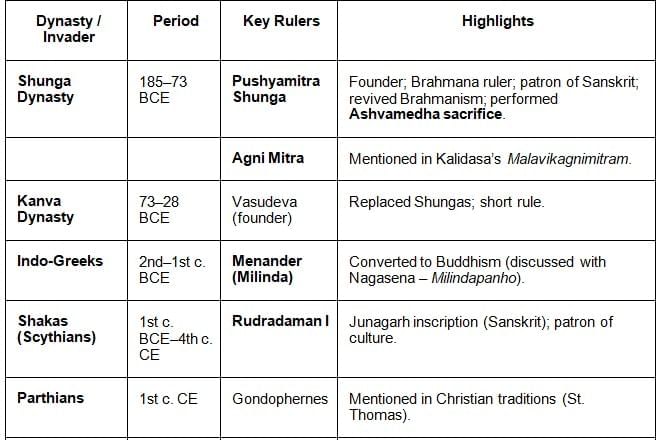SSC CGL Exam > SSC CGL Notes > General Awareness for SSC CGL > Cheat Sheet: Post-Mauryan
Cheat Sheet: Post-Mauryan | General Awareness for SSC CGL PDF Download
| Table of contents |

|
| Timeline |

|
| Major Dynasties & Invasions |

|
| Society, Economy & Culture |

|
| Characteristics of the Era |

|
Timeline
- Mauryan Decline: 185 BCE (last ruler Brihadratha killed by Pushyamitra Shunga).
- Pre-Gupta period: ~185 BCE – 320 CE.
- Marked by: Foreign invasions, Regional kingdoms, Rise of trade, Cultural developments.
Major Dynasties & Invasions


Society, Economy & Culture
- Trade: Indo-Roman trade flourished; Roman gold coins found in South India.
- Ports: Bhrigukachchha (Broach), Kalyan, Tamralipti, Arikamedu.
- Religion: Spread of Buddhism & Jainism; patronage by Kushanas, Indo-Greeks.
- Art & Architecture:
- Gandhara art (Greek influence) → Buddha depicted in human form.
- Mathura art (indigenous style).
- Amaravati & Nagarjunakonda stupas.
- Literature:
- Milindapanho (dialogue between Menander & Nagasena).
- Malavikagnimitram by Kalidasa (mentions Shungas).
- Gathasaptashati by Hala (Satavahana ruler).
Characteristics of the Era
- Political fragmentation (many regional powers).
- Rise of foreign dynasties (Indo-Greeks, Shakas, Kushanas).
- Flourishing trade with Rome & Central Asia (Silk Route).
- Fusion of cultures (Indo-Greek, Indo-Scythian, Indo-Parthian, Kushana).
- Cultural achievements laid foundation for Gupta “Golden Age”.
The document Cheat Sheet: Post-Mauryan | General Awareness for SSC CGL is a part of the SSC CGL Course General Awareness for SSC CGL.
All you need of SSC CGL at this link: SSC CGL
|
448 videos|1497 docs|288 tests
|
FAQs on Cheat Sheet: Post-Mauryan - General Awareness for SSC CGL
| 1. What were the major dynasties that emerged after the Mauryan Empire? |  |
Ans. After the fall of the Mauryan Empire, several significant dynasties emerged in ancient India, including the Shunga Dynasty, the Kanva Dynasty, and the Satavahana Dynasty. The Shunga Dynasty ruled from approximately the 2nd century BCE and is known for its contributions to art and culture, particularly in the form of Buddhist sculptures. The Kanva Dynasty followed the Shungas and is recognized for its relatively short reign. The Satavahana Dynasty, which succeeded them, played a crucial role in trade and cultural exchange, particularly with the Western regions of India and the Roman Empire.
| 2. How did the invasions during the post-Mauryan period impact Indian society and culture? |  |
Ans. The post-Mauryan period saw several invasions, including those by the Greeks, the Scythians, and the Kushans. These invasions significantly influenced Indian society and culture by introducing new ideas, art forms, and technologies. The interaction between the invaders and local populations led to a fusion of cultures, which enriched Indian art, architecture, and trade practices. The Kushan Empire, in particular, is noted for promoting Buddhism and facilitating trade along the Silk Road, which had lasting effects on the cultural landscape of India.
| 3. What were the key characteristics of society during the post-Mauryan era? |  |
Ans. The society during the post-Mauryan era was marked by a blend of various cultural influences due to invasions and trade. There was an emphasis on urbanization, with cities becoming centers of trade and culture. The caste system continued to be significant, with a growing emphasis on social stratification. Additionally, the period saw advancements in literature, philosophy, and the arts, particularly with the patronage of various dynasties, leading to a rich cultural milieu.
| 4. What were the economic foundations of the post-Mauryan period? |  |
Ans. The economy during the post-Mauryan period was characterized by agriculture, trade, and craft production. Agriculture remained the backbone of the economy, supported by advancements in irrigation and farming techniques. Trade flourished, particularly with the establishment of trade routes connecting India to the Mediterranean and Central Asia. Urban centers became hubs for artisans and craft production, leading to increased economic activity and wealth generation in the region.
| 5. How did cultural developments during the post-Mauryan period influence later Indian civilization? |  |
Ans. The cultural developments during the post-Mauryan period had a profound impact on later Indian civilization. The spread of Buddhism and the patronage of the arts led to significant advancements in sculpture and architecture, exemplified by the rock-cut caves and stupas. The period also saw the compilation of important texts in philosophy and literature, which laid the groundwork for future intellectual traditions in India. This cultural renaissance contributed to the rich tapestry of Indian civilization that would influence subsequent dynasties and cultural movements.
Related Searches














